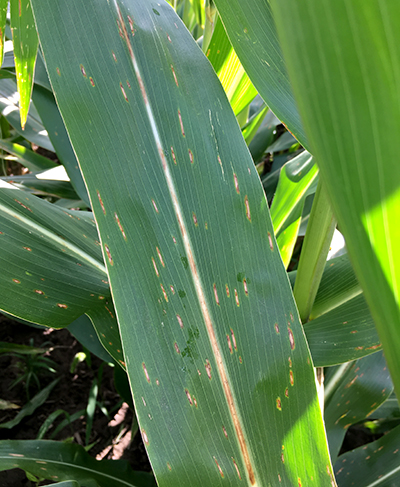Corn disease management decisions
Get out and scout now for foliar fungal diseases and ear mold diseases.

Factors that are likely to increase a return on a foliar fungicide investment include a history of disease, tight rotations, use of a susceptible hybrid, disease pressure at tasseling and weather conditions at tasseling and during grain fill.
Foliar disease management
Foliar fungal diseases of primary concern in Michigan are northern corn leaf blight and gray leaf spot. The fungal pathogens that cause these diseases survive on residue, so fields under minimum tillage and corn-on-corn rotations are at greatest risk. Spores from both of these pathogens can either be splashed up onto foliage or deposited by the wind.
Northern corn leaf blight can be identified by the distinctive lesions that form on the leaves. Lesions start out as light green, but develop into the tell-tale tan or gray “cigar”-shaped lesions. Gray leaf spot lesions typically appear two to three weeks prior to tasseling as narrow, long, rectangular (up to 2 inches) lesions and are light tan, typically delineated by the veins.
Crop rotation will reduce the amount of inoculum of northern corn leaf blight and gray leaf spot present at the start of the season, and tillage can also help to break down corn residue. Scout fields before making a fungicide application. When scouting fields, walk into the field beyond the headland as disease is typically worse along the edge of the field, especially since that is where it is exposed to prevailing winds.
Common rust is another disease typically seen, but often not at economic levels. The rust fungi require a living host to survive. Urediniospores of common rust survive the winter on corn in the southern United States, and are then carried long distances by wind to reach the Midwest. Rust pustules typically appear in late June and are favored by high humidity and moderate temperatures. Most hybrids are fairly resistant and common rust severity is typically not severe enough to warrant selecting resistant hybrids. Crop rotation does not influence common rust disease as it does not survive on residue.

Gray leaf spot on corn.
Ear mold management
Ear mold diseases of primary concern in Michigan are Gibberella and Fusarium ear mold. If you are considering making a fungicide application for ear mold suppression, it would be best to use a DMI group fungicide. Currently, Proline is the only fungicide labelled for ear mold suppression in Michigan. The application timing concept is similar to that for managing head scab in wheat. Application timing needs to coincide with silking, as this is the primary infection point for Gibberella ear mold. Studies out of Ontario have demonstrated that an application at full silking gives the best suppression.
Applications of the QoI or strobilurin group of fungicides during flowering have been demonstrated to increase DON levels (vomitoxin) in corn, just like it can in wheat, so caution should be used with this group of fungicides during this period if DON is of primary concern.
In collaboration with Michigan State University assistant professor of cropping systems agronomy Maninder Singh and supported by the Michigan Corn Marketing Program of Michigan, we are currently conducting trials across the state to examine the efficacy of Proline in reducing ear molds and mycotoxins.
MSU Extension suggests considering the following factors to determine if a foliar fungicide is warranted:
- Susceptibility level of corn hybrid. Corn hybrids that are susceptible to disease are more likely to benefit from a foliar fungicide.
- Previous crop. Corn following corn is more likely to develop disease as many of the pathogens survive on corn debris. High levels of corn residue on the surface can increase the severity of disease. Rotation can help to significantly reduce disease pressure.
- Weather. Rainy or humid weather conditions are generally favorable for most foliar diseases; hot, dry conditions typically arrest foliar disease development.
- Irrigation. Frequent irrigation provides moisture for disease development and can exacerbate disease.
- Field history. Planting corn in a field that has a history of foliar disease can increase the chances of disease development. Field location can also influence disease development such as low areas of a field or areas surrounded by trees.
- Disease presence. Is a fungal foliar disease present? The greatest chance of return on a foliar fungicide investment occurs when conditions favoring disease are present, and when fungal disease develops. Losses due to bacterial diseases such as bacterial leaf streak will not benefit from a fungicide application.
- Economics. Foliar fungicides can be used to manage northern corn leaf blight and gray leaf spot, but may not be profitable, especially given current corn prices. Damon Smith at University of Wisconsin-Madison has a nice article summarizing the economics of corn foliar fungicides, “In-Season Corn Disease Management Decisions – 2017.”
Additional resources
- Corn foliar fungicide efficacy chart from MSU Extension
- Arrested ear development, including use of non-ionic surfactants from Purdue University Extension
- Bacterial leaf streak from MSU Extension



 Print
Print Email
Email